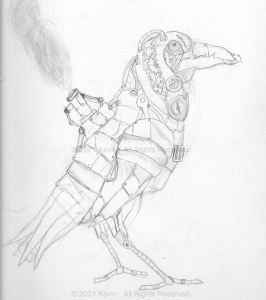E.B. White, celebrated author of Charlottes’ Web, said, “Creation is in part merely the business of forgoing the great and small distractions.” As this past winter winded down, my parents’ health setbacks and estate issues stabilized enough so that I could pause weekly trips home. This allowed me to prepare for Minicon 58, one of my favorite sci-fi/fantasy conventions.

My pent up creativity was spent on three convention activities. First, I again helped with the kid/teen Rumpus Room (for a previous post, click here). After my recent comic book indexing project, I started a free comic book “store” to encourage young readers to read comics (made up of a variety of acquisitions and donations from my own collection). This “Comic Book Nook” store sparked nice discussions, and a contribution of trade paperbacks.

My other notable Rumpus Room activity was organizing an all-ages activity called “Team Puzzle Challenge.” For each task, I wrote a fun short sci-fi/fantasy narrative to set up each logic puzzle/obstacle the team faced (several derived from the “River Crossing Logic Puzzle” premise). I played sound effects for each task, including Darth Vader’s theme song that played while the blindfolded, “wounded” team fled Darth Vader through the halls to an escape pod. There, they tackled a code-breaking task they had to solve to escape. I’ve done events like this before to help give kids subtle leadership experience (adapting a leadership reaction course from my military training).
![]() Second, I helped with the convention’s newsletter, the Bozo Bus Tribune. My writing and reporting submissions ranged from news blurbs to panel reviews. I also did a micro-fiction prompt about time travel/prophesy paradoxes (inspired by guest-of-honor Wesley Chu’s The Art of Prophecy). This flurry of writing fiction, news, and critiques is an intense writing exercise I always look forward to.
Second, I helped with the convention’s newsletter, the Bozo Bus Tribune. My writing and reporting submissions ranged from news blurbs to panel reviews. I also did a micro-fiction prompt about time travel/prophesy paradoxes (inspired by guest-of-honor Wesley Chu’s The Art of Prophecy). This flurry of writing fiction, news, and critiques is an intense writing exercise I always look forward to.

Lastly, I was honored to moderate the panel, “How to Write Disabled Characters.” Compliments afterwards affirmed my prep work paid off, but the MVP was Lisa Freitag. She recruited excellent panelists for this touchy topic. The three panelists I shared the stage with were Lois McMaster Bujold, Michael Merriam, and Guy Stewart:
![]() • Lois’s stellar writing accolades testify to the countless readers and writers she’s influenced, myself now included. The photo of her here shows her necklace, which is made entirely of her writing awards (Hugos, Nebulas, “Grandmaster”, etc., click here for a full list).
• Lois’s stellar writing accolades testify to the countless readers and writers she’s influenced, myself now included. The photo of her here shows her necklace, which is made entirely of her writing awards (Hugos, Nebulas, “Grandmaster”, etc., click here for a full list).
![]() • Michael Merriam’s a popular, prolific panelist for a reason–his personal essay about a child mistaking him for the blind Matt Murdock/Daredevil should be required reading for anyone attempting to write a physically disabled character (link here).
• Michael Merriam’s a popular, prolific panelist for a reason–his personal essay about a child mistaking him for the blind Matt Murdock/Daredevil should be required reading for anyone attempting to write a physically disabled character (link here).
![]() • Guy Stewart’s touching personal stories and writing tips often caused a mindful hush in the room.
• Guy Stewart’s touching personal stories and writing tips often caused a mindful hush in the room.
I’m biased, but after the hour discussion I think everyone left wiser. Difficult panels on challenging topics like disabled characters is why I love Minicon! Our panelists had such a great experience that afterwards several of us agreed to work on a sequel panel next year. That panels plans to discuss a topic that arose during discussions: how elderly characters are portrayed (as of 2022, CDC data states 43.9% of people aged 65 years and older have some kind of disability, such as cognition or mobility).

Inspired by elderly characters, my April creativity surge also included a “drabble” (a tiny-story) submission to a Writers Digest Contest 135. The writing prompt image reminded me of a vengeful prank story my middle & high school theater director shared with me (five decades after her lake shenanigans). My story wasn’t a finalist, yet I adored my “inspired by true events” drabble. Like many unpublished stories, I hope to repurpose its fun elements into a future story. This brief writing and editing exercise was refreshing, so weeks later I did another “first sentence” submission to Writers Digest contest 136.
These recent writings, albeit small and inconsequential, were the first productive creative writing I’d done in a year. As 2025 unfolds, I’m still working at White’s advice of “forgoing the great and small distractions” of life. But I’m also learning that enjoyable distractions are important too (for mental health). This all means my writing schedule must adapt. Gone are days or week-long writing hermit stints. Now, I must strategize to squeeze in shorter, or ad hoc, time slots for writing bits like this long overdue, frequently delayed, three-part blog/journal post.
Related, my attitude must also adapt to reduce frustration. So, I’m trying more of the popular French saying, “Que Sera, Sera” (a “cheerful fatalism” attitude). For example, two weeks ago I had to have some urgent, but minor, melanoma surgery. This included two follow-up visits within a month, all three trips being 6-8 hour round-trip drives. No stress—I get to binge Lois McMaster Bujold’s audiobooks! Then, last week a powerful storm near Itasca State Park caused blow-down trees that are blocking a family property’s forest roads—a dozen in one spot alone stopped me from assessing the rest of the property (pics shown). No stress—it’s not an urgent task, so I’ll clear these trees when weather’s cooler and there’s less bugs!

So, time—and a “Que Sera, Sera” mentality—will tell when I can do more extensive creative writing and revisions. Regardless of one’s approach to writing amid interruptions, I’ll end with a Benjamin Franklin quote I find helpful for writers:
“Either write something worth reading or do something worth writing.”
Well said. My “do something” list has priority nowadays, but that’s okay. My “write something” ideas are percolating for whenever I can squeeze in writing. Best wishes to all working on creative projects between life’s distractions!





























































































































































































 Everyone needs a Rumpus Room.
Everyone needs a Rumpus Room.



























